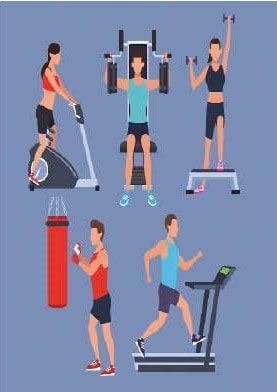BLOG
Our blog will feature our Healthy Lifestyle article on Ang Peryodiko Newspaper: Rehab and Exercise Tips. This will also be a guide to our Rehab and Therapy clients.
|
Written by: Taylor Post Certified Athletic Therapist When it comes to exercise, there a two kinds of people in the world. Those who love cardio (cardiovascular exercise), and those who avoid it like the dentist. If you would rather have a root canal than sweat it out on the treadmill, look no further! We have come up with some creative ways for you to skip the elliptical and help introduce some cardio into your workouts. First off, why is cardio so important anyway? Aerobic exercise burns calories to help keep a healthy weight, lower blood pressure, and increase cardiac output. This means more blood is pumped with each heartbeat, which leads to less overall stress on your heart and a lower resting heart rate. A stronger heart also makes daily activities like climbing stairs and moving your body at home or at work much easier. As much as cardio gets a bad rep, it is a true foundation of physical fitness… but it often leads to hours of plodding along like a zombie among the rows of exercise machines at the gym. Is anyone else sick of watching re-runs on HGTV or the food network while jogging?? Instead, try these 4 sneaky, less monotonous ways to get the benefit of a cardio workout. Try an AMRAP
Superset with a Cardio MoveInject your regular strength routine with an exercise or movement that will elevate your heart rate. Superset means moving from one exercise to another without a break in between. Simply pair up a traditional strength exercise, with one that is more cardio based. This will keep your heart rate and metabolism up without hindering your weight training goals to build muscle. Aim to perform 3-4 sets of 6-15 repetitions. You can rest 60-90 seconds between sets, but not between the two different exercises (eg. perform 10 jumping jacks followed immediately by 10 goblet squats, then rest 60-90 seconds. Repeat for 3-4 rounds). We have listed some awesome combinations below to get you started:
High Intensity Interval Training (HIIT) or Tabata WorkoutThis type of workout requires you to work at a very high intensity for short periods of time. For example 20 seconds of work, followed by ten seconds of rest, for a total of four minutes. Or, 40 seconds of work, followed by 20 seconds of rest, for four rounds (16 minutes). You can adjust the interval lengths based on the difficulty of the exercises and your fitness level. HIIT or Tabata workouts are incredibly efficient workouts because they require your body to work harder to return to its resting state. They also pack a big punch in a short amount of time, which is perfect if you are short for time. Non-Traditional Cardio
While there is no denying the benefits of regular cardiovascular exercise, that doesn’t mean it’s easy to make cardio a regular routine. The Canadian Physical Activity Guidelines state that adults should accumulate at least 150 minutes of moderate- to vigorous-intensity aerobic physical activity per week, in bouts of 10 minutes or more (Canadian Society for Exercise Physiology, 2011). Just remember that if you keep an open mind and get creative, there are plenty of ways to get your heart rate up. You shouldn’t feel confined to the treadmill!
0 Comments
12/20/2019 4 Comments How to Make Exercise a Daily Habit Written by: Taylor Post Certified Athletic Therapist Insahyu Training and Therapy Habits, good and bad, form a massive part of our day. With a New Year fast approaching, many people want to know how to get motivated to exercise and make working out a daily habit. You already know the many benefits of exercising – from increased energy, improved mood and reducing your risk for a number of health issues. Of course, wanting to make exercise a daily habit and actually doing it are two completely different things. Changing your behaviour is hard and can be more of a mental battle than a physical one. Here are some simple strategies to help you make exercising a daily habit. 1. Set a time and stick to your schedule Schedule when you are going to exercise based on the time of day that you are most likely to stick to your plan. Whether that is early in the morning, over your lunch break, or after work, just try your best to keep it consistent. This will help form the habit. Treat your workout as you would a work meeting or dentist appointment and at it on your calendar or phone as a reminder. 2. Lay out gear and pack your bag the night before Make sure that you have everything that you will need for the gym laid out or packed before you go to bed every night. This includes your running shoes, workout clothes, headphones and water bottle. Whatever you can do to make getting up and ready for the day easier and smoother, the more likely you will be to get your workout done each day. 3. Start Small and Progress Later When you first start exercising you will likely have a lot of energy and motivation, but pushing yourself too much to soon can lead to burnout and make you more likely to quit your habit. The key is to get started, move your body every day and form that pattern of behaviour. You might start by going to the gym for five minutes and that is great. Focus on the habit first and the results later. Once your body is used to daily exercise, you can start to increase the length and intensity of your workouts, and the results will be even more noticeable. 4. Make it enjoyable If you can chose a form of exercise that you don’t absolutely dread you will be more likely to keep doing it consistently. If you hate running, don’t chain yourself to the treadmill. This could mean circuit training or a fun fitness class, take up swimming, yoga or even something as simple as walking outdoors. You can also make exercising more enjoyable by giving yourself a reason to look forward to your workout, you can download new music to listen to, plan to watch your favourite show while running on the treadmill, invite a friend to join you at the gym or buy a new outfit to wear. 5. Exercise Even When You’re Too Tired Chances are you will feel better after you exercise. Remember, it does not have to be the hardest workout of your life, but just going and doing a small workout will leave you feeling energized, refreshed and keep your new habit going strong. 6. Take a Relative Rest Day Recovery is very important and it is necessary to allow your body a chance to rest. However, you don’t always want to skip the day completely, because then you aren’t being consistent with your habit. Instead try to find an activity that allows for active recovery. For example, if you are strength training most days of the week, on your “rest day” could involve going for a walk, swim or bike ride. 7. Be Kind to Yourself Remember that you are human and it is likely that you will slip up from time to time while beginning your fitness journey. Life gets in the way and practical concerns like a busy schedule, family commitments and health problems can act as barriers to exercising each day. Do not get discouraged or punish yourself if you miss a workout. It happens. However, try your best to reset as soon as possible and get back to your exercise routine as soon as possible, to maintain the habit. 12/8/2019 0 Comments Outdoor Winter Activities
Outdoor activities to consider in winter are walking, running, snowshoe hikes, snowboarding, ice skating, tobogganing or ice fishing. The winter gear checklists apply to all activities mentioned and it is as simple as layering. The only difference will be the footwear for specific activities. Cold Weather Layering
If you’re unsure where to shop for this outdoor gear, visit your local outdoor stores like MEC, Sport Chek, Atmosphere Polo Park, North Face Winnipeg / The Prairie Summit Shop, Woodock Cycle Works, Mountain Warehouse, Running Room, Wilderness Supply and Cabela’s Winnipeg. Maintaining your fitness level year-round is very important. The winter season can be tougher but there are many health benefits in doing outdoor activities. Fresh air is good for your health especially when cooped up indoor all winter long. When the sun is out, it is a bonus. We could use more sunlight during winter. Planning to maintain your fitness level during winter helps reduce heart conditions, improve mental health, increase physical well-being, and bringing others together will give you sense of community and belonging that could bring positive impact into your life. You Might also like:
BALANCE EXERCISES TO PREVENT FALLS Please do not miss our Simple Workout videos on our YouTube channel > Insahyu Training + Therapy with our new segment > Exercises for expecting moms. |
AuthorTeam Insahyu: Certified Athletic Therapists. CategoriesAll Anatomy Arms Athletic Tape Athletic Therapy Back Pain Conditions Elbows Exercises Healthy Lifestyle Hips Knees Orthotics Pregnancy Rehab Tips Running Shoulders Stretching Tips Treatments Winter Wrists |
Location |
|
